The Gearing class was the US Navy’s final destroyer design of WWII. Without question, it was the best and most sophisticated destroyer class of WWII. Many naval historians consider it the best destroyer design ever. These ships served long after WWII in the US Navy, then were transferred around the world, serving many navies on four continents. The Mexican navy received two of these ships. One, ARM Netzahualcoyotl, ended up being the last Gearing on active duty in the world.  USS Steinaker (DD-863) was launched on 13 February 1945 at Bethlehem Steel’s Staten Island, NY shipyard. The ship commissioned on 26 May 1945.
USS Steinaker (DD-863) was launched on 13 February 1945 at Bethlehem Steel’s Staten Island, NY shipyard. The ship commissioned on 26 May 1945.
 (USS Steinaker (DD-863) during WWII, in the original Gearing configuration.)
(USS Steinaker (DD-863) during WWII, in the original Gearing configuration.)
USS Steinaker saw no actual combat during WWII, as the ship had been attached to the US Navy’s 6th Fleet in the Atlantic and Mediterranean after Germany had already surrendered.
In 1964, USS Steinaker, like many other Gearings, underwent a FRAM conversion. The Hedgehog ASW mortars and “B” twin 5″ gun turret were removed, making way for two sets of triple ASW torpedo tubes. The amidships ship-to-ship torpedoes were replaced by a RUR-5 Asroc anti-submarine missile launcher. All of the WWII-era light (40mm, 20mm, .50cal) guns were removed, as were the depth charge racks. A helipad and small hangar for the QH-50 DASH drone helicopter was added. Infrared-retarding caps were added to the stacks. The radios, radars, and sonars were completely overhauled, and some structural changes were done. 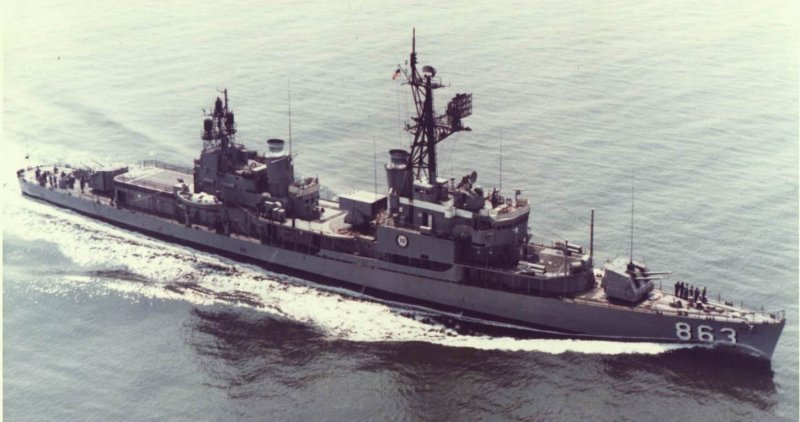
(USS Steinaker after the FRAM conversion, with the “B” turret replaced by two triple ASW tubes. The three black antennas atop the new DASH hangar are the AN/WLR-1 electronic warfare system. The “chokers” on the WWII-era stacks were meant to reduce the heat signature vs modern infrared sensors. The QH-50 DASH heli-drone was largely unsuccessful and later abandoned.)
In 1968, the modernized USS Steinaker made a combat tour off Vietnam, bombarding ashore targets with her 5″ guns. On 1 July 1973, USS Steinaker was decommissioned and transferred to the Atlantic Fleet’s 10th Destroyer Squadron naval reserve proficiency program. As such, the ship had no permanent crew and was moored pierside at Baltimore, MD; so that US Naval Reservists from Maryland and Virginia could fulfill their “….one weekend a month” obligation. This continued until 1981, when the old destroyer was judged insufficient.
Transfer to Mexico
On 24 February 1982, the US Congress agreed to the sale of the ex-USS Steinaker to Mexico. The Mexicans renamed the ship ARM Netzahuacoyotl, initially with the pennant number E-04. The destroyer was sold along with USS Steinaker‘s sister ship, the ex-USS Vogelsang (DD-852), which became ARM Quetzacoatl. The terms of the sale were fairly generous; the Mexicans did not pay much more than their scrap metal value. Basically for the USA, it was a way to clear out some reserve anchorages without the hassle of bidding a scrap job. For Mexico, it was a prime opportunity to add two open-ocean combatants to their navy, whatever their age.
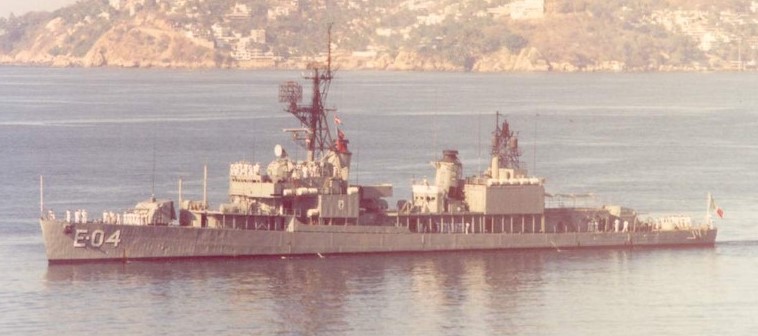 (ARM Netzahuacoyotl departs for a patrol in the Pacific Ocean in 1991. The pennant number is still E-04. The Mexican navy had a spree of ship renamings and renumberings in the 1990s and E-04 later changed to E-11 and then again to D-102.)
(ARM Netzahuacoyotl departs for a patrol in the Pacific Ocean in 1991. The pennant number is still E-04. The Mexican navy had a spree of ship renamings and renumberings in the 1990s and E-04 later changed to E-11 and then again to D-102.)
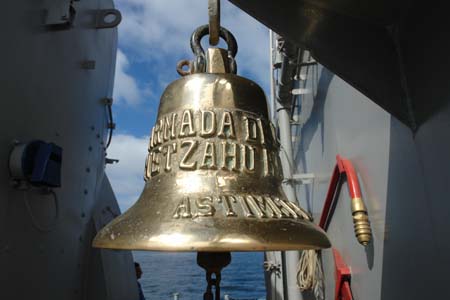 (ARM Netzahuacoyotl’s bell, which was forged in Mexico after the transfer. Since the Revolutionary War, US Navy sailors have held a superstitious respect for ship’s bells and American bells are usually removed before ex-US Navy warships are sold abroad. US Navy veterans of a certain age might recognize the red object on the bulkhead, it is an old fog applicator extension for firefighting.)
(ARM Netzahuacoyotl’s bell, which was forged in Mexico after the transfer. Since the Revolutionary War, US Navy sailors have held a superstitious respect for ship’s bells and American bells are usually removed before ex-US Navy warships are sold abroad. US Navy veterans of a certain age might recognize the red object on the bulkhead, it is an old fog applicator extension for firefighting.)
Initially no modifications were done to the ship. For Mexico, their prime assets were their range, seaworthiness in bad weather, long-range air search radars, and anti-submarine weapons.
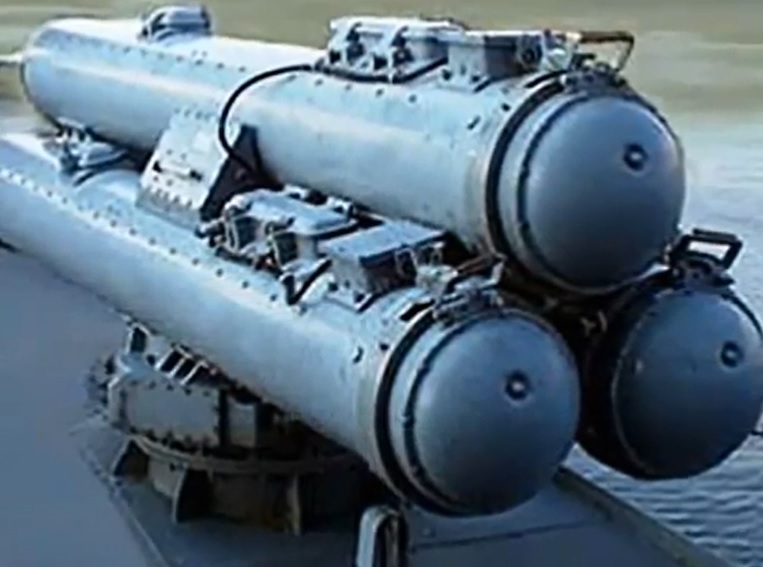 (One of ARM Netzahuacoyotl’s two Mk32 Mod7 324mm torpedo tube banks. These fired the Mk46 acoustic-homing ASW torpedo with a range of about 5 miles.)
(One of ARM Netzahuacoyotl’s two Mk32 Mod7 324mm torpedo tube banks. These fired the Mk46 acoustic-homing ASW torpedo with a range of about 5 miles.)
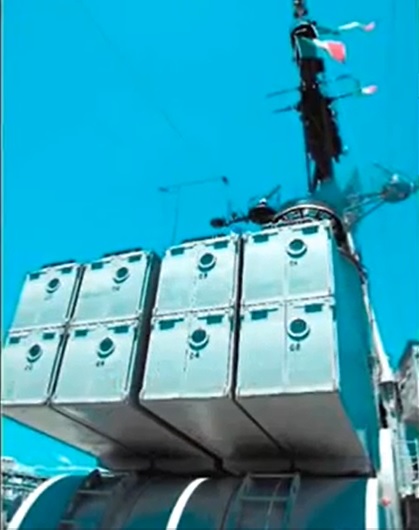 (ARM Netzahuacoyotl’s Mk112 launcher, which American sailors called “the pepperbox”, with the Mexican flag above. This launcher, installed in the 1960s to replace the WWII-era anti-ship torpedoes, fired RUR-5 Asroc ASW missiles out to 12NM range. Asroc missiles carried a homing torpedo and dropped it into the sea directly over the target submarine’s position. Normally, a submarine can detect a regular incoming torpedo and take evasive maneuvers. With Asroc, there was only a few seconds between the torpedo splashdown and it’s impact. Mexico also used the RUR-5 on it’s more modern Bronstein and Knox class warships, so ARM Netzahuacoyotl was a good training asset.)
(ARM Netzahuacoyotl’s Mk112 launcher, which American sailors called “the pepperbox”, with the Mexican flag above. This launcher, installed in the 1960s to replace the WWII-era anti-ship torpedoes, fired RUR-5 Asroc ASW missiles out to 12NM range. Asroc missiles carried a homing torpedo and dropped it into the sea directly over the target submarine’s position. Normally, a submarine can detect a regular incoming torpedo and take evasive maneuvers. With Asroc, there was only a few seconds between the torpedo splashdown and it’s impact. Mexico also used the RUR-5 on it’s more modern Bronstein and Knox class warships, so ARM Netzahuacoyotl was a good training asset.)
The hangar built during the FRAM upgrade was sized for the long-forgotten little DASH heli-drone and was too cramped for a regular 1980s-era helicopter. None the less, the flight deck was still usable and the Mexican navy sometimes used ARM Netzahuacoyotl as a landing spot.
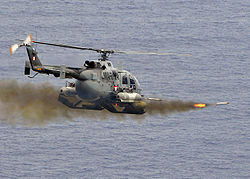 (A German-made Bo-105 helicopter of the Mexican navy firing a rocket.)
(A German-made Bo-105 helicopter of the Mexican navy firing a rocket.)
The two remaining Mk38 twin 5″ gun turrets were kept in immaculate condition by the Mexicans. They did not regard them as museum pieces and maintained excellent gunnery standards with these WWII weapons into the 21st century.
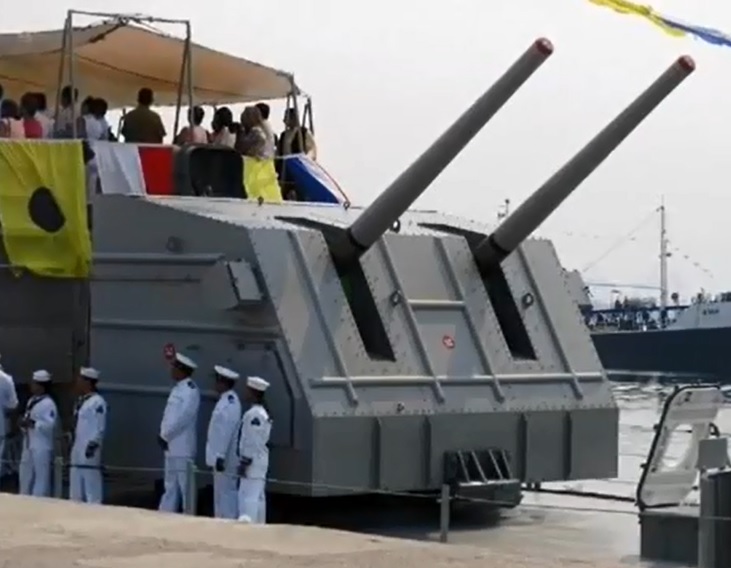 (The WWII-veteran aft Mk38 twin 5″ gun aboard ARM Netzahuacoyotl during a friendship visit to the USA in the 2000s.)
(The WWII-veteran aft Mk38 twin 5″ gun aboard ARM Netzahuacoyotl during a friendship visit to the USA in the 2000s.)
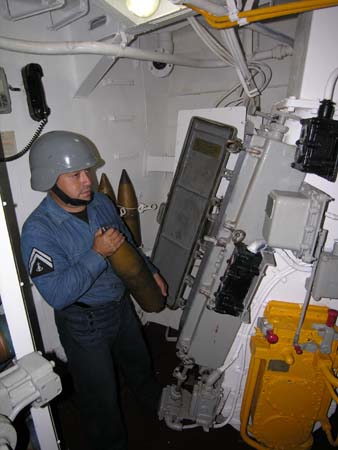 (A Mexican sailor, with modern kevlar PASGT helmet, loads a 5″ shell into the magazine shuttle for transport up into the WWII turret.)
(A Mexican sailor, with modern kevlar PASGT helmet, loads a 5″ shell into the magazine shuttle for transport up into the WWII turret.)
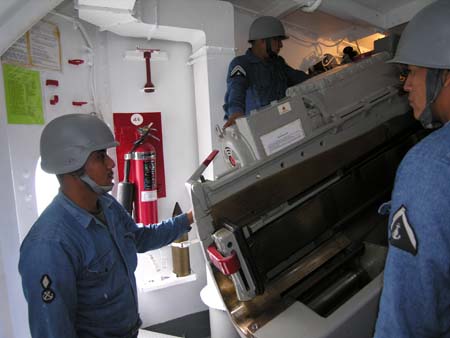 (The inside of one of ARM Netzahuacoyotl’s twin 5″ turrets during the 2000s. This shows the hand-loaded breech mechanism of the WWII-era 5″ guns. The helmets are a mix of modern kevlar PASGT and old WWII-era M1 steel pots. Considering age, the gun and the turret’s interior are in pristine condition. The Mexican navy has high shipboard standards.)
(The inside of one of ARM Netzahuacoyotl’s twin 5″ turrets during the 2000s. This shows the hand-loaded breech mechanism of the WWII-era 5″ guns. The helmets are a mix of modern kevlar PASGT and old WWII-era M1 steel pots. Considering age, the gun and the turret’s interior are in pristine condition. The Mexican navy has high shipboard standards.)
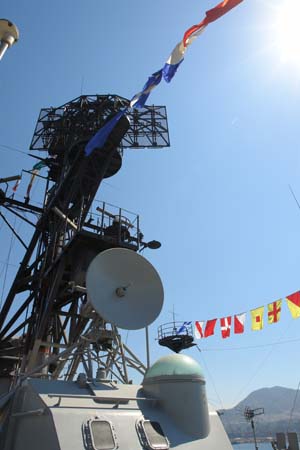 (Aboard ARM Netzahuacoyotl during the 2000s. The structure, with controlman’s bubble, in the foreground is a Mk37 director which dates back to WWII. Atop it is a Mk22 gunnery radar. This system controlled the gunfire of the 5″ weapons. On the mast can be seen the two modern AN/SPS-59 navigation radars which were added by Mexico after the transfer, and the large AN/SPS-29 air search radar which was installed during the FRAM upgrade.)
(Aboard ARM Netzahuacoyotl during the 2000s. The structure, with controlman’s bubble, in the foreground is a Mk37 director which dates back to WWII. Atop it is a Mk22 gunnery radar. This system controlled the gunfire of the 5″ weapons. On the mast can be seen the two modern AN/SPS-59 navigation radars which were added by Mexico after the transfer, and the large AN/SPS-29 air search radar which was installed during the FRAM upgrade.)
Mexican operations
Initially, the role of ARM Netzahuacoyotl was supposed to be peacetime training and wartime ASW patrols in the Pacific Ocean. The ship’s age and limited abilities were not really important, as the Mexican navy is in a unique strategic position: sandwiched between an infinitely stronger superpower navy north of the Rio Grande; and much weaker and smaller third-world navies south of the Yucatan.
As it turned out, the USA’s war on drugs, which intensified during the 1980s, ended up being the ship’s main duty. Normally, ARM Netzahuacoyotl patrolled a sea zone of the Pacific just south of the Baja peninsula northwards up to the sea border of the USA. This area was rife with trawlers, yachts, and small boats smuggling drugs from South America towards California.
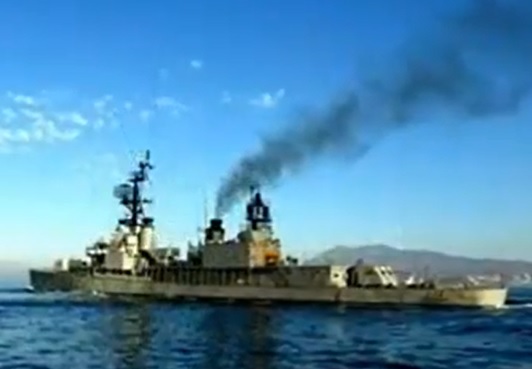 (ARM Netzahuacoyotl departing port for a “narcopatrol” in the Pacific Ocean.)
(ARM Netzahuacoyotl departing port for a “narcopatrol” in the Pacific Ocean.)
For these anti-drug missions, ARM Netzahuacoyotl‘s main assets were the ship’s wide operating radius and the air search radar. The 1960s-vintage AN/SPS-29 was obsolete in a military context by the 1990s, but, it could still detect a DC-3-sized smuggling plane at high altitude out beyond 100NM, and even small Cessnas at wavetop height out to about 38NM.
Since ARM Netzahuacoyotl‘s radios were all American, they were compatible with those of the US Coast Guard. Any suspected smuggler which ARM Netzahuacoyotl could not chase down, was vectored via radio to the DEA or US Coast Guard. The helipad allowed search helicopters a safe place to land at sea if needed. Unlike the Mexican navy’s small fiberglass anti-drug boats, the sturdy WWII-built ARM Netzahuacoyotl was not deterred by severe weather.
For the crew, a highlight of serving aboard ARM Netzahuacoyotl was a yearly visit to San Diego, CA. The Mexican navy often offered the American public tours of the old warship. If visitors were WWII-era US Navy veterans, especially old destroyermen, the crew of ARM Netzahuacoyotl went out of their way to welcome them, often showing the old-timers normally restricted areas such as the weapons magazines and radar room.
The SAK Mk.2 gun trials
In 1993, ARM Netzahuacoyotl was selected as the trials ship for the modern SAK Mk.2 gun. Manufactured by Bofors in Sweden, this 57mm autocannon is unmanned and housed in a plastic-composite structure designed for low observability by radar. It fires at 220rpm and is radar-controlled. For the trials, the two torpedo tube banks were removed and the SAK Mk.2 was installed on a temporary platform where the “B” Mk38 turret had once been, long ago in WWII.
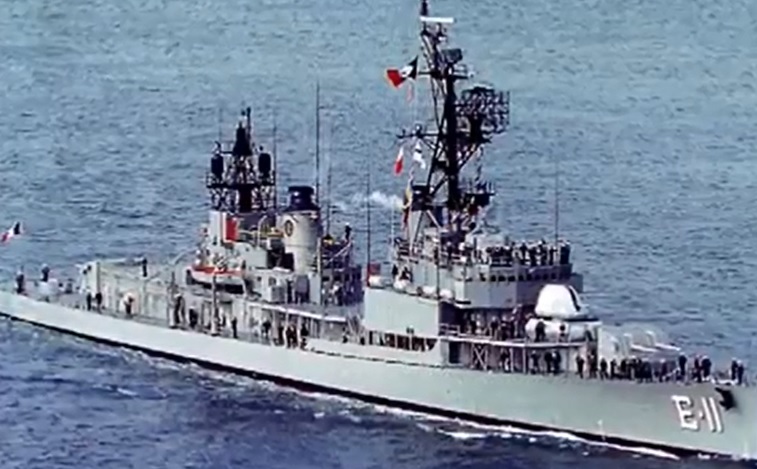 (The white Bofors 57mm autocannon installed aboard ARM Netzahuacoyotl in the mid-1990s. This photo also shows the final radar fit, with the black AN/SPS-29 and smaller AN/SPS-10 sets from the FRAM upgrade, along with the white, bar-shaped Kelvin Hughes 17/9 modern system installed by the Mexicans at the end of the 1980s atop the mast. The two AN/SPS-59 sets on the yardarms are hard to make out but there. The old AN/WLR-1 electronic warfare radomes remain aft.)
(The white Bofors 57mm autocannon installed aboard ARM Netzahuacoyotl in the mid-1990s. This photo also shows the final radar fit, with the black AN/SPS-29 and smaller AN/SPS-10 sets from the FRAM upgrade, along with the white, bar-shaped Kelvin Hughes 17/9 modern system installed by the Mexicans at the end of the 1980s atop the mast. The two AN/SPS-59 sets on the yardarms are hard to make out but there. The old AN/WLR-1 electronic warfare radomes remain aft.)
The Bofors autocannon was generations ahead of the old WWII guns and made an interesting contrast being carried on the same ship as them. Tests were successful, and the Mexican navy purchased this gun system for other new-build warships. During the tests, the Asroc launcher was also taken ashore for cleaning and repairs.
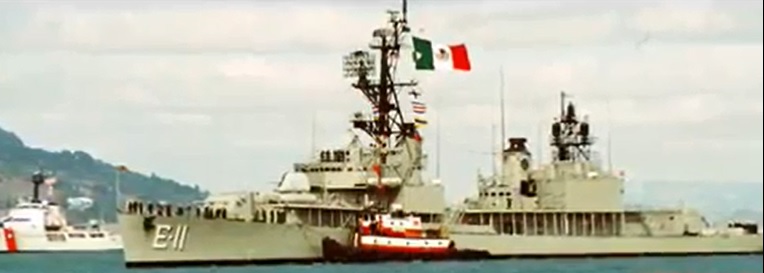 (ARM Netzahuacoyotl in the 1990s, with the Bofors 57mm mount aboard and torpedoes and Asroc temporarily taken off. A Reliance class cutter of the US Coast Guard is in the background.)
(ARM Netzahuacoyotl in the 1990s, with the Bofors 57mm mount aboard and torpedoes and Asroc temporarily taken off. A Reliance class cutter of the US Coast Guard is in the background.)
After the conclusion of the tests, there was some thought given to leaving the SAK Mk.2 aboard as it was quite popular with the destroyer’s crew. However (at that time) it was thought that ARM Netzahuacoyotl would decommission soon, so it was moved to new warship under construction. The torpedo tubes and missile launcher were reinstalled.
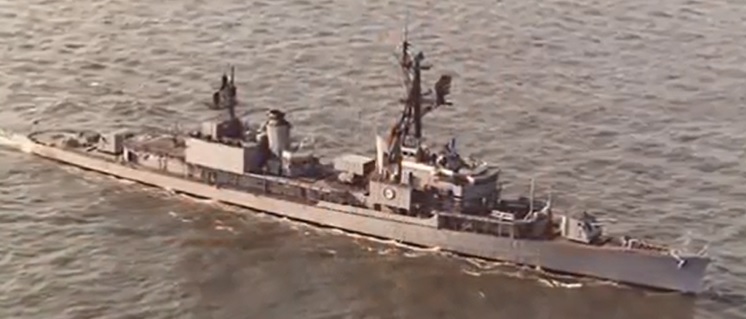 (The two triple torpedo tubes and amidships Asroc launcher back aboard after the gun tests. This was originally a Mexican navy press photo and the pennant number was airbrushed out for security.)
(The two triple torpedo tubes and amidships Asroc launcher back aboard after the gun tests. This was originally a Mexican navy press photo and the pennant number was airbrushed out for security.)
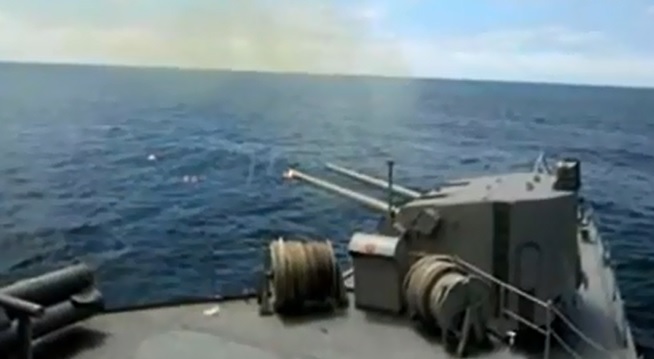 (The WWII-era forward 5″ guns of ARM Netzahuacoyotl in action in the early 2000s. These long-obsolete guns were battle ready right up until the end. To the right of the port side torpedo tubes, is a discolored area of deck where the 57mm gun mounting had been.)
(The WWII-era forward 5″ guns of ARM Netzahuacoyotl in action in the early 2000s. These long-obsolete guns were battle ready right up until the end. To the right of the port side torpedo tubes, is a discolored area of deck where the 57mm gun mounting had been.)
Final years
In 2002, Mexico’s other WWII-era Gearing class destroyer, ARM Ilhuicamina (formerly ARM Quetzalcoatl, before that USS Vogelsang) was decommissioned and it was expected that ARM Netzahuacoyotl would shortly follow. However because of the drug war, it remained in service. It was also used as a training ship for midshipmen of the Mexican naval academy.
After the turn of the millennium, the biggest handicap was the 1940s steam plant. As steam propulsion operates under high pressure and high moisture, the metal ages and there is little that can be done to reverse it after so many decades of use. ARM Netzahuacoyotl typically did not exceed 17kts after the year 2000 unless absolutely necessary.
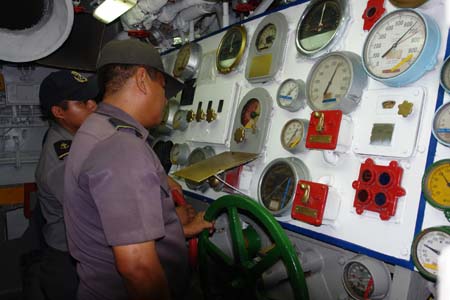 (ARM Netzahuacoyotl’s engineering officer of the watch monitors the WWII-era steam board in the late 2000s. The handwheel controls the amount of steam sent from the boilers to the geared turbines which turned the propeller shafts.)
(ARM Netzahuacoyotl’s engineering officer of the watch monitors the WWII-era steam board in the late 2000s. The handwheel controls the amount of steam sent from the boilers to the geared turbines which turned the propeller shafts.)
In 2010, it was announced that the ARM Netzahuacoyotl would shortly decommission however this was again extended. A new issue at that time was ordnance. By then, the 5″ ammunition had gone out of production worldwide and Mexico’s remaining stockpile was beginning to be depleted. The RUR-5 missile had just been phased out by the US Navy, so Mexico’s remaining inventory of that missile (which cost about $375,000 each) had to be shared with more modern frigates and ARM Netzahuacoyotl obviously had last priority.
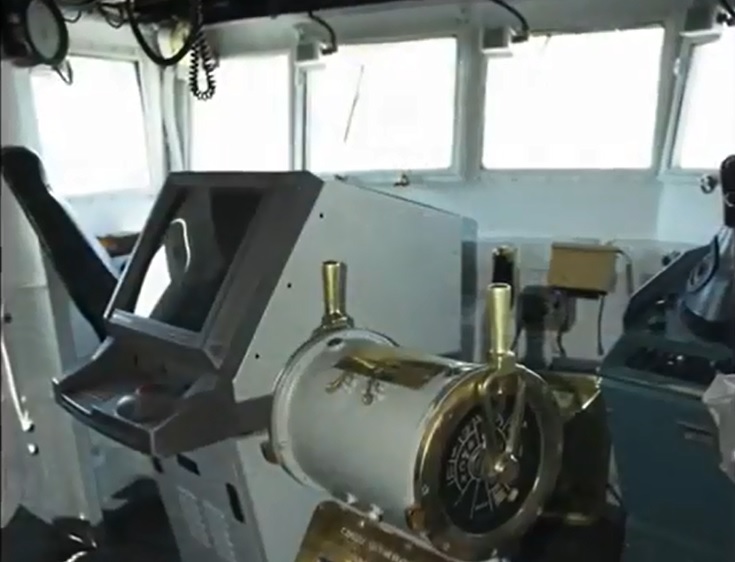 (Old and new on the bridge of ARM Netzahuacoyotl in the 2010s.)
(Old and new on the bridge of ARM Netzahuacoyotl in the 2010s.)
Last of the Gearings
In the 1990s and 2000s, the other still-remaining operators of FRAM’ed WWII-veteran Gearing class destroyers (Iran, Brazil, South Korea, Pakistan, and Taiwan) phased theirs out. By 2011, the only other example in military use was the Pakistani coast guard’s Nazim (formerly USS Damato) which was an inoperable and stripped pierside tender. ARM Netzahuacoyotl was the last Gearing still patrolling the sea, six and a half decades after WWII ended.
In 2012, it was announced that ARM Netzahuacoyotl would decommission in 2013. However the month kept getting pushed back. In December 2013, SEMAR (an organization headed by Mexico’s secretary of the navy) conducted a bow-to-stern survey of ARM Netzahuacoyotl. It was determined that the ship was safe to operate for several more months, but no more than a year. The team stated that the propulsion, hydraulic, and electrical systems were too old to refurbish and the ship was not worth refitting again. The team stressed that the hull itself, and the WWII-era 5″ guns, were still in excellent condition.
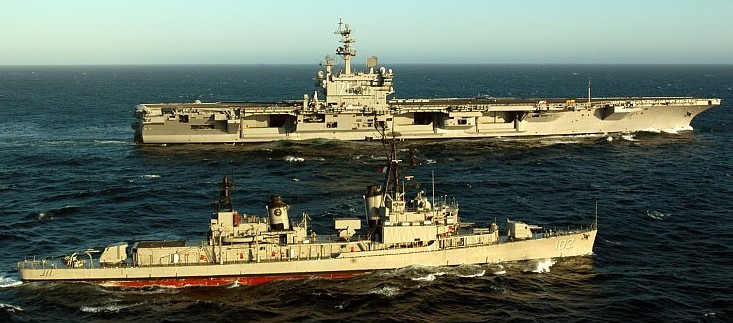 (ARM Netzahuacoyotl on 21 June 2005 during a joint exercise with USS Ronald Reagan (CVN-76) in the Pacific.)
(ARM Netzahuacoyotl on 21 June 2005 during a joint exercise with USS Ronald Reagan (CVN-76) in the Pacific.)
ARM Netzahuacoyotl made her final patrol in September 2014, just shy of 70 years of service. As of 2015, it is planned to strip the ship of salvageable equipment and scuttle the hulk as a scuba diving attraction.

Reblogged this on Brittius.
LikeLike
Great article!
LikeLiked by 1 person
In the 80s, I was supervising in the ESM system upgrades on three of the ex-Gearings for the Pakistani Navy in Karachi. The world was in a different place back then, but the multiple trips to Karachi and subsequent sea trials (as the ESM system operator) were eye openers, to say the least.
LikeLiked by 1 person
In the 1990s, they still had one (I believe PNS Nazim but I might be wrong) in service with their coast guard.
LikeLike
Great article.. I served aboard USS DAMATO DD871 in 66-67 and USS FURSE DD882 in 68-69.. Both were great ships!!
LikeLiked by 1 person
Good article. It’s not true that when the Steinaker went off active duty it had no permanent crew. I served aboard her on active duty from 1977-1981. There were about 200 active duty crew members. We trained reserves but also on many occasions sailed without reserves.
LikeLiked by 1 person
It’s a pity that Mexico isn’t going to preserve her as a museum, but being sunk as a reef beats being turned into razor blades I suppose.
LikeLiked by 1 person
I was a Machinist Mate 3rd class in Main Control on STEINAKER, she was a good ship had a good crew and served with honor. What I learned on there went with me through life on FDNY then with the Army Engineers as an engineer on one of their boats.
LikeLiked by 1 person